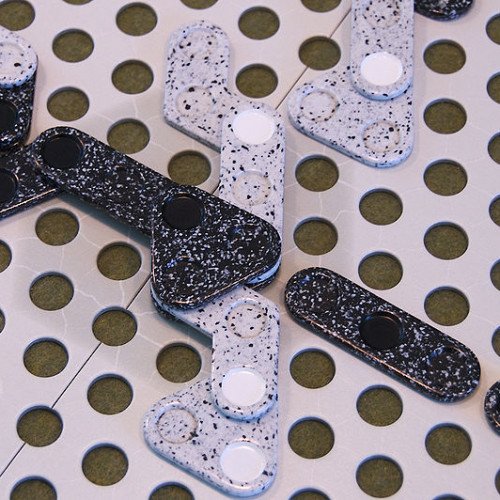PÜNCT VS SHATAR

PÜNCT
PÜNCT is a two-player strategy board game. It is the sixth (and final) release in the GIPF project of six abstract strategy games, although it is considered the fifth game in the project. It was released in 2005. PÜNCT won the Games Magazine Best Abstract Strategy game for 2007. The PÜNCT board game is one of six games a part of the GIPF project. This project was created by Kris Burm and is a series of six abstract games. PÜNCT is the 5th game of the project and the board of this game is shaped like a hexagon. This game was released in 2005.[citation needed] PÜNCT is a two-player connection game. The objective is to connect two sides of a hexagonal board, using pieces which cover three hexes each. The pieces can be placed, moved, rotated, and stacked in various ways, restricted by the geometry of the board, the shape of the pieces, and gravity. Players can bring new pieces to the board or can attempt to connect the pieces already in play. The objective of the game is to mislead the opponent. When the players take their first turn, they are not able to use the central hexagon. The PÜNCT piece is used as a point of reference throughout the game, but the PÜNCT piece can't be moved when the player is making a move. Minor dots can land on the other player's piece, but the PÜNCT piece may not. In order to make a move, three dots must be in perfect alignment. The pieces that are on top of all of the other pieces have the most power in this game. The dots on the ends of the pieces must be at the same level horizontally to play this game correctly. In order to make a bridge in this game, you must perform a jump move on a piece already on the board. The positions of the dots at the end don't have to be aligned with the middle or stable horizontally. When determining the winner, a player can lift one piece at a time to determine if a connection was made. To connect opposite sides in this game, players can move pieces on top of other pieces or they can stack pieces to block the opponent's connection, ergo, making a connection for themselves. The actual PÜNCT piece, which is a rounded piece that has one point, cannot be used to make a connection or form a “chain” but rather used as a point of reference.
Statistics for this Xoptio

SHATAR
Shatar (Mongolian: ᠮᠣᠩᠭᠣᠯ ᠰᠢᠲᠠᠷᠠ Monggol sitar-a, "Mongolian shatranj"; a.k.a. shatar) and hiashatar are two chess variants played in Mongolia. The rules are similar to standard chess; the differences being that: The noyan (ᠨᠣᠶᠠᠨ, lord) does not castle. The küü (ᠬᠦᠦ, pawn) does not have an initial double-step move option, except for the queen pawn or king pawn. In old shatar rules, a pawn that reaches its eighth rank must promote to half-power tiger. But a pawn could step back to its sixth rank to promote to all-power tiger. It moves like a queen. The baras (ᠪᠠᠷᠰ or ᠪᠠᠷᠠᠰ, tiger; Persian: fers) moves like a promoted rook in shogi: like a chess rook or one square diagonally. It was called half-power tiger or half-power lion in old shatar rules. In modern shatar rules, a baras moves like a queen. The mori (knight; ᠮᠣᠷᠢ) cannot deliver mate. In modern shatar rules, the mori can give mate. The bishop (teme) and rook (terge) move as they do in standard chess. The game always starts by White playing 1.d4 and Black responding with 1...d5. This is the only time in the game a pawn may advance two squares; some sources claim this initial move can optionally be made with the e-pawn. In old shatar rules, Ujimqin player must make an initial double-step move with the queen pawn; in Chahar, the king pawn. In old shatar rules, baremate is draw. In old shatar rules, one special rule is called tuuxəi, like komi in Go. A player could leave the enemy with only two pieces remaining (noyan and another piece) at the end. Then he must start making checks using the terge or baras and make consecutive checks until checkmate. Before checkmate, number of consecutive checks is the number of tuuxəi. If a player wins by checkmate as in chess, he receives only one tuuxəi. A player usually leaves the enemy with one noyan and one küü to allow time to put his pieces into good positions for making consecutive checks.